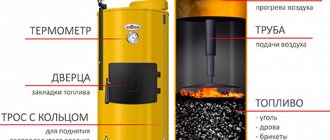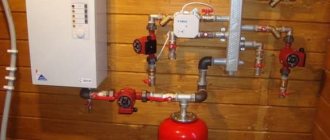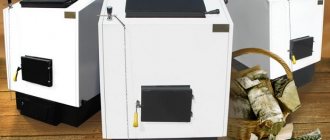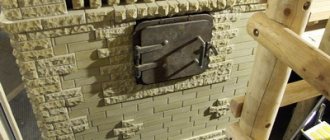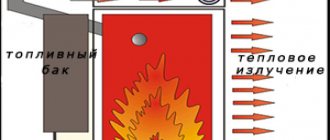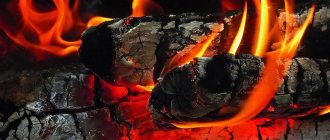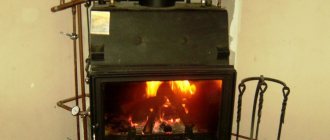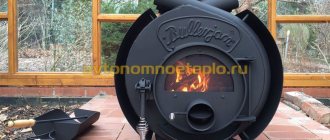Unit design
The body base of the equipment is usually an all-welded frame made of thick metal. The design provides for the infrastructure of a combustion chamber with conventional pipes through which hot gases circulate. The coal stove also has a system of outlet pipes for connecting to the chimney, a locking mechanism and doors with a damper. The lower part is formed by an ash collection system with grates and passing blower channels. Some modifications provide a cooking floor, which must be heated to high temperatures. Again, depending on the modification and customer requirements, decorative elements may also be present - including in the form of a stylistic design of the convector, ash drawer and door.
Types of coal stoves
Design designs may vary depending on the power characteristics, size and diameter of the inlet and outlet pipes, but models made from different body materials will always have fundamental differences.
Metal is the basis in most cases, but which alloy should be preferred? The main competition is between steel and cast iron structures. The former are famous for their high thermal conductivity, can be repaired in case of serious damage by the same welding and almost do not form carbon deposits on their surfaces. On the other hand, steel does not tolerate condensation well, which can cause corrosion in the future.
What can a cast iron coal stove boast of? This is the traditional and most popular design of solid fuel units, which is explained not only by good thermal conductivity, but also by protection from negative external processes - both thermal and hydrochemical such as corrosion. But cast iron has a weak point. While a steel body can be repaired, a crack in a cast iron structure cannot be repaired.
Functional elements
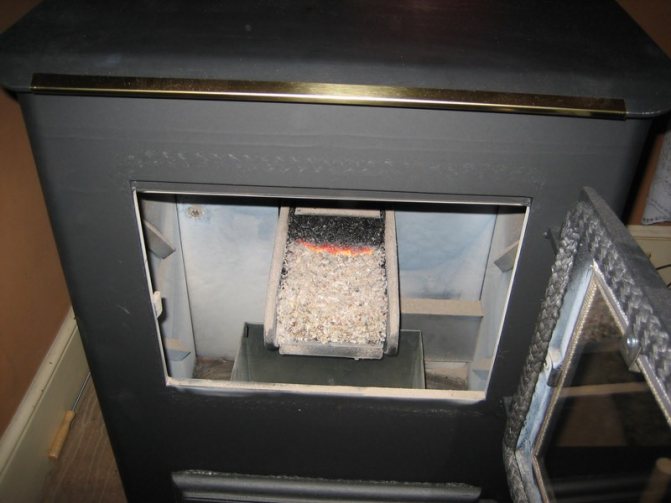
As heating equipment designs develop, approaches to the implementation of functional mechanics also change. Modern furnace systems have the following set of working parts:
- Door. As a rule, it opens 120 degrees, allowing you to load fuel material and control the combustion process. By the way, doors with a translucent screen do not require opening at all for visual observation of the processes inside the firebox.
- Convection pipes. It cannot be said that this is a fundamentally new solution, but optimization of the structural interface with the firebox has made the conventional system more efficient in terms of heat transfer.
- Metal grates for a coal stove also increase the efficiency of the thermal process, ensuring uniform combustion throughout the entire depth of the firebox.
- The presence of protective sleeves in the design increases the operational life of the unit. These elements take on the thermal impact of burning fuel, thus protecting the base of the furnace structure.
- The damper and, in general, the infrastructure for interacting with the chimney are the most important component of the stove from the point of view of regulating the combustion process by controlling air draft, but this operational nuance will be considered separately.
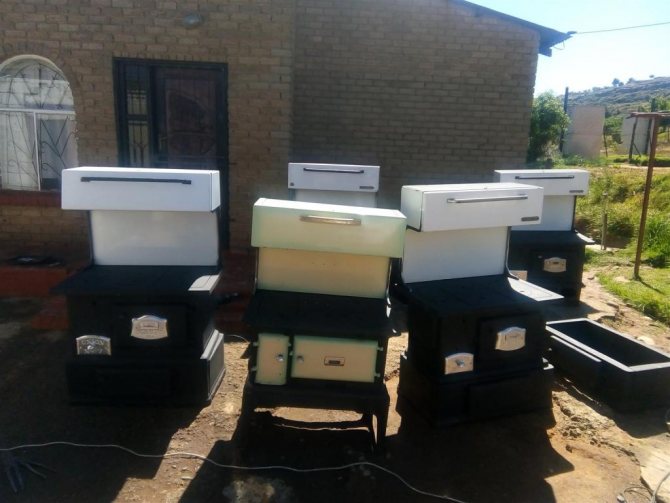
The operating principle of wood and coal stoves
Technologies do not stand still. And gradually a new trend is gaining popularity. These are so-called long-burning furnaces. This design increases the combustion time of firewood by 2 times, and coal by 3 times.
The operating principle of such a furnace is based on forced air supply and fuel combustion in the upper chamber. The fuel is pressed down with a special weight, which sinks lower and lower as it burns. The air is pumped using a fan.
This principle is fundamentally different from the classical one, when combustion occurs due to the supply of air from below, through the blower.
The stove can use any solid fuel: brown coal, anthracite, briquettes, sawdust, firewood, etc. The fuel supply process can be automated. In this mode, the oven can operate for up to several weeks. As in the classic version, there is an ash chamber located below. It is separated from the combustion chamber by a grate.
Features of double-circuit furnaces
Like modern models of electric and gas boilers, coal stoves support the ability to provide a hot water supply (DHW) system. For this purpose, a special channel is provided for heating water and circulating it through pipes to its final destination - the kitchen, bathroom or other consumers. However, to implement such a system, several technological conditions must be met in advance.
Firstly, a coal stove for a house with water heating will be able to effectively distribute the coolant across two circuits only with the support of a circulation pump. Secondly, in order to reduce the time for hot water to enter the circuit, it is recommended to provide a buffer tank in the system. For a private home, you can use a storage tank with heating circuits of 30-50 liters. The water in this tank will be constantly hot in accordance with the oven automation settings.
Long burning coal gas generator furnace
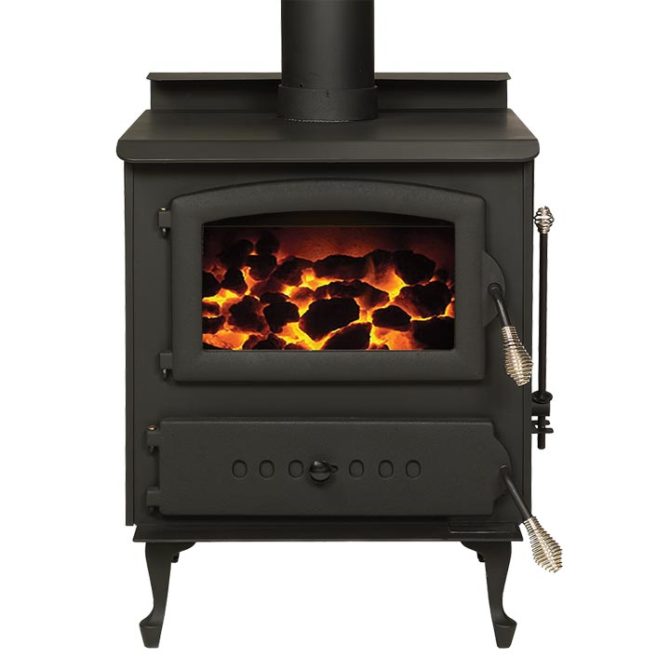
Coal furnace
Coal ranks second in terms of efficiency after gas. Long-burning coal stoves for homes have become most popular in regions where wood fuel is very expensive. The heat transfer coefficient of coal is higher, so the main fuel in many homes is brown coal or anthracite. Another advantage is the automatic operation of the furnace for loading and burning. This is unusual for wood-burning analogues.
The combustion process of coal is also different from wood. A greater increase in temperature is observed precisely on the surface of the fuel, and the smoke remains relatively cold upon exiting. Thus, the effect of long-burning coal stoves is the large size of the load and the placement of the heat exchanger directly in the fuel combustion zone.
Also, a coal stove requires forced air injection into the combustion area. Many manufacturing companies solve this problem by installing a blower fan.
Features of long-burning stoves
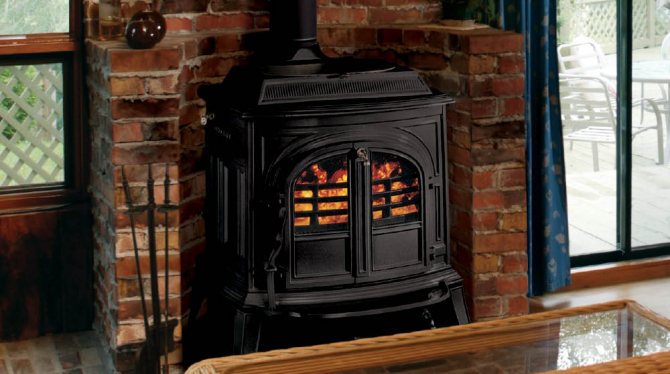
In this case, we consider one of the technologies for increasing the energy efficiency of heating equipment by regulating the flow of oxygen. As already mentioned, the gate connecting the stove structure with the chimney channel directly affects the intensity of fuel combustion. But a conventional mechanical design is largely dependent on the climatic conditions outside and, even with manual control, is not capable of producing the expected result in full.
In a modified form, a long-burning coal stove for the home is additionally provided with a compact fan unit. This is a low-power, heat-protected device whose task is to artificially regulate traction. How does the fan function affect the combustion process? Coal as such, in principle, has a long combustion time compared to firewood. Intensive air injection can increase heat generation in certain conditions or reduce it altogether. Support for long-term combustion is possible even with a minimally open damper with a damper, but it is thanks to the fan that the control of the process does not stop.
This control scheme is completely autonomous, since the operation of the cooler can be controlled automatically, connected to temperature and ventilation sensors.
How to make a charcoal kiln with your own hands
Craftsmen offer 2 ways to manufacture a unit at home; they are so simple that you don’t even always need a drawing.
First option
For self-production, you should ensure the availability of:
- metal thick-walled barrel;
- stands for the device (barrel);
- bricks;
- mineral wool.
A barrel stove is the easiest way to obtain a fireproof, efficient design.
A prerequisite is a non-flammable base. An ordinary pit with a diameter sufficient to install a barrel is suitable for this. It needs to be covered with bricks.
You will need to make a hole with a diameter of 10 cm in the bottom of the container; place it with the hole facing down.
The next stage is filling the barrel with bricks and stones. The cracks must be covered with non-flammable material, and the upper part must be insulated with mineral wool.
At this point, the installation of the structure can be considered complete. A homemade stove will not produce high-quality coal, compared to the designs described above, but it will be enough to obtain fuel for the barbecue from existing wood waste.
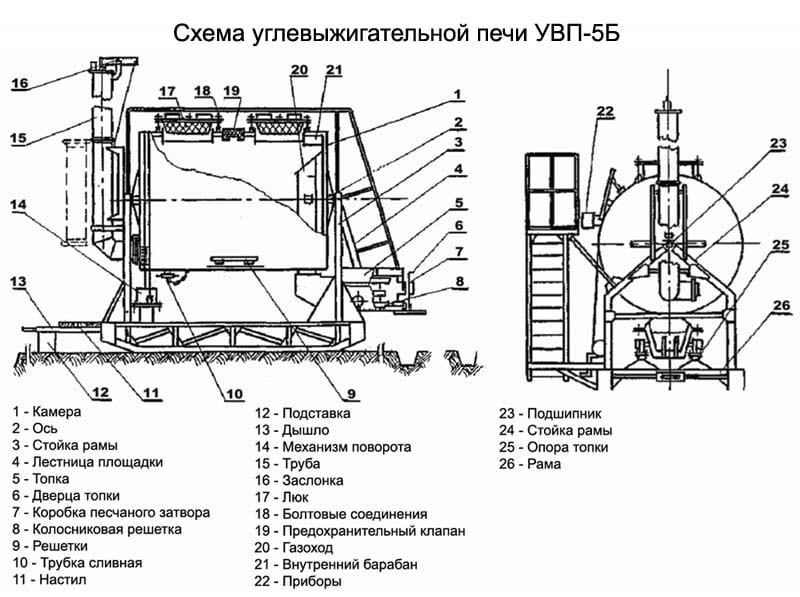
Scheme of charcoal kiln UVP-5B
Operating restrictions
The use of coal fuel and solid fuel stoves in general involves some restrictions related to basic fire safety rules. Among them, it is worth noting the following standards:
- The unit must not be used in areas where flammable materials are located. It is recommended to store coal in bags made of heat-resistant material. Another thing is that fuel cells have their own requirements in terms of storage, and the main danger in relation to coal will not be temperature, but humidity.
- Only materials approved by the manufacturer should be used as fuel. It should be noted that a coal stove for a home usually allows the use of pellets with firewood, if they are suitable in size. However, liquid fuels such as kerosene, diesel and gasoline are prohibited.
- Operation of the equipment is possible only after major installation in a room prepared for heating. These types of units are not used in mobile houses, tent structures and trailers.
Long-burning coal stoves
Anthracite coal is the highest quality and heat-intensive.
As we have already said, ash content is probably the determining factor when choosing coal. The reality is that you have many options to choose from. Usually there are several of them, since there are not so many mining sites, and besides, they transport the coal that is mined closer. Maybe the one from afar will be better, but the cost of delivery will significantly increase the final price of fuel, and in the end, consumers will still buy what is cheaper.
Long-burning coal stoves do not require special attention during operation, but they must be cleaned without fail. Fuel comes in different qualities and with different specific heat of combustion. Coal marking consists of two letters:
- the first is the variety;
- the second is the size of the fractions.
There are only three types of coal:
- brown, designated by the letter “B”;
- stone - divided into 7 sub-grades;
- anthracite – designated by the letter “A”; upon combustion, 7700–8100 kcal/kg is released.
Fractions are divided into 7 classes, ranging from small particles of unlimited size to pieces larger than 10 cm. Each class is also marked with a letter. Anthracite coal has the highest specific heat of combustion. When coal burns, toxic volatile substances are released. Lower-quality fuel has more of them, so it can only be loaded into long-burning coal stoves in small portions. This is necessary so that volatile substances have time to combine with the air and escape through the chimney.
In addition to smoke, there is another harmful factor of coal heating - dust. No matter how carefully you try to load fuel into the stove, there will still be a lot of dust and, accordingly, dirt. Long-burning wood heating stoves do not have this drawback. It is because of this negative factor that coal units should be located outside the living space.
What is the correct piping of a solid fuel heating boiler: diagram and real photos.
Water heating of a dacha with a solid fuel boiler has many advantages. Details here.
What kind of coal is suitable?
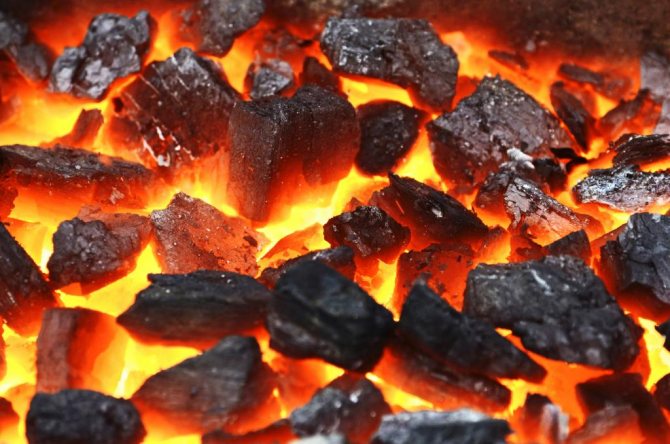
For domestic use, experts advise using anthracite grades. It maintains combustion for a long time, emits a little smoke and leaves behind a small amount of ash waste. By the way, in terms of the volume of heat generated, anthracite is adjacent to coking coal - about 8500 Kcal/kg. In this regard, the least attractive option would be brown coal, the heat release of which is at the level of 4500 Kcal/kg. On the other hand, anthracite often causes problems when igniting and is not cheap. For example, coal in 50 kg bags will cost 500-600 rubles. As the volume of one-time purchase increases, the price tag logically decreases, but relative to the same brown coal this is a higher cost.
Wood burning stoves
You can chop the firewood yourself, or you can immediately buy ready-made ones.
Firewood, as you know, is the most popular type of fuel for long-burning stoves. You can see this when we conduct a comparative analysis. Now let's talk about how to choose firewood. What is the first requirement that long-burning wood heating stoves place on the energy source? Of course, humidity. For each stove, the level of fuel moisture may be different, but optimally within 40%.
That is why firewood needs to be prepared in the spring so that it dries out before the beginning of the heating season. The calculated thermal capacity of firewood is indicated for different degrees of humidity, since the amount of water in the wood significantly affects the degree of thermal energy release.
For firewood with 20% moisture content, the thermal capacity is 3500-4100 kcal/kg. At the same time, when humidity increases to 50%, thermal output decreases to 2200 kcal/kg.
The type of wood doesn't really matter. Of course, oak gives off more heat than pine, but not critical. Therefore, wood stoves for long-burning homes must be heated with dry fuel. Moreover, each type of wood has its own characteristics that must be taken into account when choosing fuel for long-burning wood stoves:
- oak - gives a lot of heat, but is difficult to ignite;
- birch - not suitable for pyrolysis furnaces, since at low temperatures tar appears, it heavily pollutes the firebox and chimney;
- alder and aspen – have cleaning properties at high temperatures. Clean the firebox and chimney from soot;
- poplar – when it burns, it sparkles strongly;
- pine - smokes a lot because of the resin.
But pine is still the most common material for heating stoves. It is cheap and, in general, is the most common type of wood processing industry, and therefore the most waste. We have already written about how to make a long-burning stove using sawdust - this is Bubafonya, who doesn’t care what is loaded into it, even a thousand.
Furnace installation
The unit is installed on a flat surface with a heat-protective base. It would not be amiss to first prepare a screed 5-10 cm thick for the structure. As a rule, massive equipment does not require special fixation - it is enough to correctly position the body from the point of view of optimal connection with adjacent communications and the chimney.
Light coal stoves are additionally secured to the floor with metal brackets or anchor heat-resistant clamps. Again, the possibility of installing the latter should be thought out in advance when installing the screed or preparing the rough floor surface. When choosing the location of the furnace, you should also keep in mind that according to the rules for installing boiler equipment, the distance from their surface to flammable objects and wall decoration should be from 15 to 50 cm, depending on the type of material and its ability to support combustion.
Types of fuel for long-burning furnaces

Types of fuel for a pyrolysis furnace.
The well-known long-burning wood-burning stove is a fairly universal unit and can work not only on chopped logs. There are quite a lot of energy carrier options that can be used in factory models of pyrolysis furnaces, not to mention home-made designs that work on almost everything. So, energy options:
- firewood;
- coal;
- briquettes;
- pellets.
Long-burning coal stoves for homes, along with wood stoves, are most often used. This is primarily due to the cost of fuel, although the difference ultimately turns out to be not so significant. There are many factors that do not depend on us. We will talk about this a little later, considering each of these energy carriers separately. They also read about how to make a long-burning furnace for mining.
Pellets for pyrolysis stoves are rarely used; they mainly go into the firebox of classic solid fuel boilers, where there is a special tank with a metered fuel supply. Storing pellets requires more attention than storing firewood. When moisture gets on the pellets, they simply crumble, turning into an ordinary pellet. They are made from sawdust, straw, peat, waste paper or sunflower husks. There are white, gray and dark brown pellets, depending on the variety. The higher the grade, the lighter the fuel. The ash content also depends on the variety. In light pellets it is only 0.5%, which is very little. Their specific heat of combustion is a maximum of 4300 kcal/kg.
Long-burning coal stoves for home use briquettes very readily. There are several types of briquettes:
- from wood waste;
- from coal;
- from peat;
- from sunflower husks.
You should not heat a long-burning solid fuel stove with peat briquettes. The smell of smoke is so “fragrant” that neighbors may stop smiling when they meet. The stench of peat permeates the entire yard.
Wood briquettes have a fairly low humidity compared to firewood. It is no more than 10%. During combustion, 4400 kcal/kg of thermal energy is released. One briquette smolders for about four hours. Coal briquettes are compressed coal dust. When burned, they release 5200 kcal/kg of thermal energy and can smolder for up to 10 hours. Also, such products have quite acceptable ash content, which is 28%.
With thermal energy, everything is simple - the more heat one kilogram of fuel emits, the better. But with the percentage of ash content the opposite is true. The latter is of utmost importance for a long-burning solid fuel stove. What is ash content? These are impurities in solid fuel that do not burn and remain in the form of ash. It not only falls into the collection tank, but also settles on the walls of the stove and chimney. The normal limit for the ash content of coal is from 1 to 15%, this is if non-combustible particles are dispersed dispersed in the organic structure of coal, the so-called internal ash.
If the particles are of inorganic origin, the so-called external ash, then the ash content of coal can reach 60%. Ash content is an indicator of the quality of the energy carrier. It affects not only the efficiency of fuel combustion, but also increases transportation costs for delivery, since it is useless, even harmful, ballast. Because of these particles, coke is formed, which clogs long-burning coal furnaces.
How to make an electric boiler for heating a house with your own hands so that you don’t get electrocuted during operation?
The function of a stabilizer for an electric heating boiler is described here.
Chimney installation
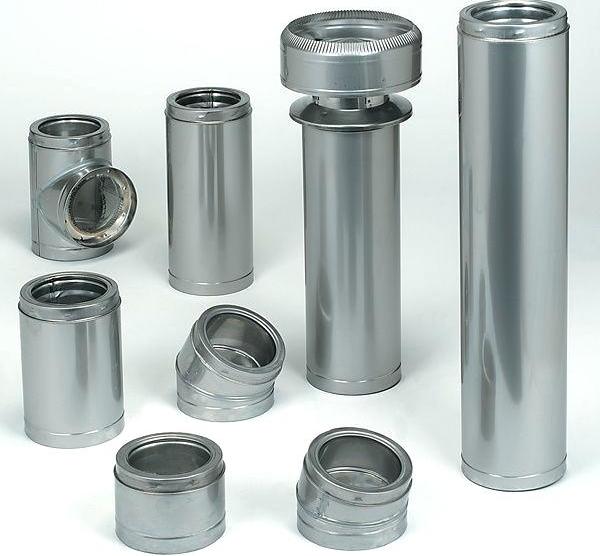
To organize the removal of combustion products in private homes, it is recommended to use modular pipes. Manufacturers of such equipment offer complex sandwich structures with the necessary fastening and connection units. An essential feature of a modular chimney of this type is the presence of a thermal insulation layer and the ability to withstand hot gas temperatures of about 1000 °C.
As for installation, coal stoves in one-story buildings are usually designed to have an outlet up to 5 m high. Assembly is carried out using clamp and lock joints, which are provided in the design of the elements. The main task of the contractor is to think in advance about the points of attachment of the contours to the walls and prepare a technological hole in the roof covering. For this purpose, special exits with deflectors and draft regulators are also provided.
Preparing for the workflow
Immediately after installation, it is necessary to check the reliability of the structure, the condition of the working parts, the presence of a grate and an ash box. It is advisable to carry out the first warm-up with the ventilation running and the windows open. This is important so that not only combustion products are removed, but also harmful factory oils that coated the structure during preservation.
The test intense combustion mode should be maintained for about 1 hour, after which the unit should be left until it cools completely. There is no need to touch its internal surfaces at this stage, since after heating the internal heat-resistant paint will gain stability for some time.
How to light a stove?
There are special operating modes for heating furnaces and boilers running on coal. The main feature of this process is the dosed loading of the combustion chamber relative to one firing session. For example, how to heat a stove in standard mode for several hours? A series of fillings are carried out, each of which should form a layer of no more than 15 cm. As it decreases by approximately 50-60%, the volume of fuel can be replenished. If difficulties arise with ignition, then you should always have thin firewood in stock for kindling. On top they are also covered with a layer of fine coal 5-7 cm high.
